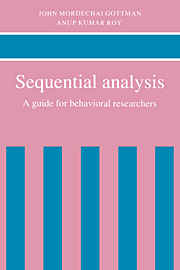Book contents
- Frontmatter
- Contents
- Preface
- Reading this book quickly
- Part I Introduction
- Part II Fitting the timetable
- Chapter 4 The order of the Markov chain
- Chapter 5 Stationarity of the Markov chain
- Chapter 6 Homogeneity
- Chapter 7 Everyday computations of stationarity, order and homogeneity
- Chapter 8 Sampling distributions
- Chapter 9 Lag sequential analysis
- Part III The timetable and the contextual design
- References
- Index
Chapter 5 - Stationarity of the Markov chain
from Part II - Fitting the timetable
Published online by Cambridge University Press: 10 November 2009
- Frontmatter
- Contents
- Preface
- Reading this book quickly
- Part I Introduction
- Part II Fitting the timetable
- Chapter 4 The order of the Markov chain
- Chapter 5 Stationarity of the Markov chain
- Chapter 6 Homogeneity
- Chapter 7 Everyday computations of stationarity, order and homogeneity
- Chapter 8 Sampling distributions
- Chapter 9 Lag sequential analysis
- Part III The timetable and the contextual design
- References
- Index
Summary
Our plan in sequential analysis is to compare the likelihood of the occurrence of a sequence for two groups. For example, do fathers smile as often in response to their infant's smiles as mothers do? Obviously, to answer such questions we will have to estimate parameters of sequential connection from our samples and will want to believe that these estimates are, in some senses, “stable”. What is meant by “stable?”
Stationarity is a concern with the stability of our parameters of sequential connection over time. Homogeneity is a concern with the stability of our parameters of sequential connection across subjects. Recall that we only estimate these parameters from our sample, so we need tests of statistical significance to decide whether, given our data, the parameters are likely to differ, say from the first to the second half of the interaction.
The reader should consider the assessment of stationarity as a decision that is not automatically made by one significance test. Unfortunately, this has come to be the way stationarity is usually viewed – the test for stationarity is seen only as a precaution that must be taken for our analyses to be valid. We suggest two things: First, the decision about stationarity need not be automatic. It can depend on the researcher's judgment to a much greater degree than has been presumed in the past. Such a decision is much like deciding on an adequate reliability index for a measure; we suggest that the spirit of Cronbach et al.'s (1972) generalizability conceptions can be applied to a discussion of stationarity.
- Type
- Chapter
- Information
- Sequential AnalysisA Guide for Behavorial Researchers, pp. 60 - 66Publisher: Cambridge University PressPrint publication year: 1990
- 1
- Cited by



